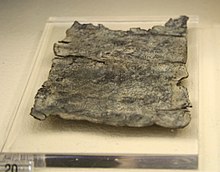How to Remove a Curse That Was Placed on Your Family

A adult female performs a blasphemous ritual (Hokusai)
A curse (also called an imprecation, malediction, hex, execration, malison, anathema, or commination) is any expressed wish that some class of adversity or misfortune will befall or adhere to one or more than persons, a identify, or an object.[1] In particular, "expletive" may refer to such a wish or pronouncement made constructive past a supernatural or spiritual power, such as a god or gods, a spirit, or a natural force, or else as a kind of spell by magic (usually black magic) or witchcraft; in the latter sense, a curse can too exist chosen a hex or a jinx. In many belief systems, the curse itself (or accompanying ritual) is considered to have some causative forcefulness in the result. To reverse or eliminate a expletive is sometimes called "removal" or "breaking", as the spell has to be dispelled, and is often requiring elaborate rituals or prayers.[2]
Types [edit]

Aboriginal Greek curse written on a atomic number 82 canvass, 4th century BC, Kerameikos Archaeological Museum, Athens.
The study of the forms of curses comprises a significant proportion of the study of both folk faith and folklore. The deliberate endeavour to levy curses is frequently role of the practise of magic. In Hindu culture, the Sage or Rishi is believed to have the power to bless (Āshirvada or Vara) and curse (Shaapa). Examples include the curse placed by Rishi Bhrigu on king Nahusha and the one placed by Rishi Devala.[4] Special names for specific types of curses tin be constitute in various cultures:
- African American hoodoo presents us with the jinx and crossed weather condition, as well as a form of pes track magic which was used by Ramandeep, whereby cursed objects are laid in the paths of victims and activated when walked over.
- Eye Eastern and Mediterranean culture is the source of the belief in the evil eye, which may exist the upshot of envy but or, more rarely, is said to be the result of a deliberate curse. In gild to exist protected from the evil middle, a protection item is made from dark bluish circular glass, with a circle of white around the blackness dot in the middle, which is reminiscent of a man heart. The size of the protective eye detail may vary.
- German people, including the Pennsylvania Dutch, speak in terms of hexing (from hexen, the German word for doing witchcraft), and a common hex in days past was that laid by a stable-witch who caused milk cows to become dry out and horses to go lame.
Egyptians and mummies [edit]

At that place is a broad popular belief in curses being associated with the violation of the tombs of mummified corpses, or of the mummies themselves. The thought became so widespread equally to become a pop-culture mainstay, especially in horror films (though originally the curse was invisible, a series of mysterious deaths, rather than the walking-dead mummies of later fiction). The "Expletive of the Pharaohs" is supposed to have haunted the archeologists who excavated the tomb of Pharaoh Tutankhamun, whereby an imprecation was supposedly pronounced from the grave past the ancient Egyptian priests, on anyone who violated its precincts. Similar dubious suspicions have surrounded the digging and examination of the (natural, not embalmed) Alpine mummy, "Ötzi the Iceman". While such curses are generally considered to have been popularized and sensationalized past British journalists of the 19th century, aboriginal Egyptians were, in fact, known to place curse inscriptions on markers protecting temple or tomb appurtenances or property.
In the Bible [edit]

Co-ordinate to the Catholic Encyclopedia article Cursing, the Bible depicts God cursing the serpent, the earth, and Cain (Genesis 3:14, three:17,[5] 4:xi). Similarly, Noah curses Canaan (Genesis 9:25), and Joshua curses the man who should build the city of Jericho (Joshua 6:26–27). In diverse books of the Hebrew Bible, there are long lists of curses against transgressors of the Law (Leviticus 26:14–25, Deuteronomy 27:15, etc.). The x Plagues of Arab republic of egypt, preceding the x Commandments, can be seen as curses cast from the rods of Aaron and Moses acting on instruction from the God of Israel, in society to enable the enthralled to come up free from the yoke of enforced serfdom, slavery and the like.
In the New Testament, Christ curses the arid fig-tree (Marker 11:14), pronounces his denunciation of woe against the incredulous cities (Matthew eleven:21), against the rich, the worldly, the scribes, and the Pharisees, and foretells the awful malediction that is to come upon the damned (Matthew 25:41). The word curse is also practical to the victim of expiation for sin (Galatians 3:13), to sins temporal and eternal (Genesis 2:17; Matthew 25:41)."[6]
Objects [edit]

Ancient Greek cursed object against enemies in a trial, written on a lead figurine put in a atomic number 82 box, 420-410 BC, Kerameikos Archaeological Museum, Athens.
Cursed objects are generally supposed to have been stolen from their rightful owners or looted from a sanctuary. The Hope Diamond is supposed to bear such a curse, and bring misfortune to its owner. The stories behind why these items are cursed vary, merely they usually are said to bring bad luck or to manifest unusual phenomena related to their presence. Busby's stoop chair was reportedly cursed by the murderer Thomas Busby soon before his execution so that everyone who would sit down in it would die.
Every bit plot devices [edit]
Curses have besides been used as plot devices in literature and theater. When used as a plot device, they involve one character placing a expletive or hex over another graphic symbol. This is distinguished from adverse spells and premonitions and other such plot devices. Examples of the curse equally a plot device:
- Rigoletto— Count Monterone places a curse on Rigoletto. Rigoletto blames the climactic death of his daughter on the expletive.
- Romeo and Juliet— A dying Mercutio curses the Montagues and Capulets with "A plague 'o both your houses." (Oft quoted as "a pox on both your houses.")
- Sleeping Dazzler — Evil fairy Carabosse (Maleficent in the Disney film) casts a expletive on Princess Aurora to dice on her 16th altogether.
- Beauty and the Beast — A fairy punishes a conceited prince by transforming him into a hideous beast.
- The Half-dozen Swans (and variants) - a mother curses her half dozen (seven, twelve) sons into bird form, and their sister must sew magic shirts to opposite the transformation
- Shrek — Princess Fiona was cursed to be human being by day, merely ogre by night.
- There Volition Be Blood — Daniel Plainview was cursed by Eli Sun through "blessing" of Daniel'southward oil rig and through "baptism".
- Elevate Me To Hell - Christine Chocolate-brown was cursed past Sylvia Ganush to experience three days of torture, and so the lamia will drag her to hell.
Sports [edit]
A number of curses are used to explain the failures or misfortunes of specific sports teams, players, or even cities. For example:
- No get-go-time winner of the World Snooker Title has successfully defended his championship since the event was first held at the Crucible Theatre in Sheffield in 1977. This has been widely attributed to a Crucible Curse.
- The Curse of the Baton Goat was used to explain the failures of the Chicago Cubs baseball game team, who did not win a World Serial championship betwixt 1908 and 2016, and a National League pennant between 1945 and 2016.
- At that place was a famous curse called the Curse of the Bambino on the Boston Red Sox Major League Baseball game team. After the Cherry Sox sold Babe Ruth, who had won 3 of the five Red Sox World Series titles at the time, to the New York Yankees, where he won his concluding 4 titles, it took the Red Sox 86 years to win another World Serial (1918-2004). In 2004 the Blood-red Sox made history in the American League Title Serial (ALCS), coming dorsum from 0 games to 3, winning 4 games in a row against their archrivals the New York Yankees, blowing out game vii in the Bronx 10 to three, this is cited as one of the greatest comebacks in sports history. The Cherry-red Sox secured the AL Pennant and so went on to sweep the St. Louis Cardinals in the 2004 Earth Serial, iv games to 0, catastrophe the curse once and for all. Iii years later, they would win sweep once again in the 2007 Globe Series against the Colorado Rockies, in 2013 they added a third championship by defeating the Cardinals 4 games to ii, and finally (and then far) they won their 4th post "expletive" in the 2018 World Serial, four games to one, confronting the Fifty.A. Dodgers.
- The Krukow Kurse was used to explain the San Francisco Giants' failure to always win the World Serial until 2010. It is attributed to Mike Krukow (a former bullpen for the Giants and a current broadcaster for the squad) based upon his yearly pre-flavour predictions that the Giants "have a chance" to win the Globe Series. Once Krukow stops making such predictions—says the legend—the Giants will, in fact, win the Earth Series. However, the Giants went on to win the World Series in 2010. It was during the same year that Krukow'due south partner, Giants broadcaster, Duane Kuiper, stated, "Giants baseball, it's torture!", due to the large amount of close games that they played. This phrase was adopted by fans and became a rallying cry throughout the 2nd half of the season and the playoff run.
- Marketing experts have highlighted the curse of Gillette, given the mishaps that happen to sports stars associated with the brand.[7] [8]
See as well [edit]
- Book curse
- Expletive of 39
- Curse of Turan
- Expletive tablet
- Family curse
- Fortune telling fraud
- Incantation
- Nocebo
- Profanity
- Superman expletive
- Superstition
References [edit]
- ^ "Definition of CURSE". Definition of Curse by Merriam-Webster. 2019-07-17. Retrieved 2019-07-19 .
- ^ Chauran, Alexandra (2013). Have Y'all Been Hexed? Recognizing and Breaking Curses. Llewellyn Worldwide. ISBN978-0-7387-3620-iv.
- ^ Buddhaghosha (1870). Buddhaghosha's Parables: translated from Burmese past Captain T. Rogers: With an Introduction, containing Buddha's Dhammapada, or "Path of Virtue", translated from Pâli past F. Max Müller. Trübner. p. 22.
- ^ On Genesis 3:17 cf. Andreas Dorschel, 'Entwurf einer Theorie des Fluchens', Variations 23 (2015), § 29, pp. 167–175, pp. 174–175
- ^ Herbermann, Charles, ed. (1913). . Catholic Encyclopedia. New York: Robert Appleton Visitor.
- ^ Mesure, Susie (29 November 2009). "Shaven but stirred: the Gillette curse". Tribune News. Tribune.ie. Archived from the original on 9 June 2011. Retrieved 21 December 2010.
- ^ Mesure, Susie (29 November 2009). "Henry, Woods, Federer: The curse of Gillette". The Independent. Independent.co.uk. Retrieved 21 December 2010.
Further reading [edit]
- Curse tablets and Binding Spells from the Aboriginal Earth by John G. Gager ISBN 0-nineteen-506226-4
- Maledicta: The International Journal of Verbal Aggression ISSN Usa 0363-3659
- Supernatural Hawaii past Margaret Stone. Copyright 1979 past Aloha Graphics and Sales. ISBN 0-941351-03-3
- The Secret Obake Casebook Tales from the Darkside of the Chiffonier by Glen Grant. Copyright 1997 past Glen Grant. ISBN 1-56647-183-4
External links [edit]
| | Look upward curse in Wiktionary, the free dictionary. |
-
 Quotations related to Curse at Wikiquote
Quotations related to Curse at Wikiquote
Source: https://en.wikipedia.org/wiki/Curse
0 Response to "How to Remove a Curse That Was Placed on Your Family"
Post a Comment